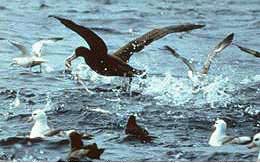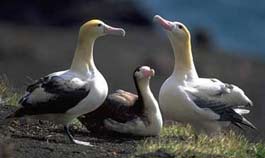Seabird Bycatch Reduction Program - The Bycatch Problem
The Seabird Bycatch Problem
The presence of "free" food in the form of offal and bait attracts many birds to fishing operations. In the process of feeding, birds sometimes come into contact with fishing gear and are accidentally killed. For example, most birds taken during hook-and-line operations are attracted to the baited hooks when the gear is being set. These birds become hooked at the surface and are then dragged underwater where they drown.

Juvenile short-tailed albatross with fish offal. Photo: North Pacific Longline Association
The Short-tailed Albatross and The Endangered Species Act
Because the endangered short-tailed albatross (Phoebastria albatrus) occurs in areas where commercial fisheries occur off Alaska, NMFS engages in required section 7 Endangered Species Act (ESA) consultations with the U.S. Fish & Wildlife Service (USFWS), the federal agency with trust responsibility for seabirds. Short-tailed albatrosses have been observed from commercial fishing vessels off Alaska and several have been reported taken. The USFWS has issued Biological Opinions that address the potential effects of the Pacific halibut hook-and-line fishery and the Bering Sea/Aleutian Islands (BSAI) and Gulf of Alaska (GOA) hook-and-line groundfish fisheries on the endangered short-tailed albatross. The USFWS Biological Opinions state that these fisheries are not likely to jeopardize the continued existence of the short-tailed albatross. But because incidental take in the fisheries is possible, an incidental take limit has been established for each fishery. For the 1999-2000 period, up to 4 short-tailed albatrosses are allowed in the BSAI and GOA groundfish hook-and-line fisheries. For the 1998-1999 period, up to 2 short-tailed albatrosses are allowed in the Pacific halibut fishery off Alaska. If either take limit were to be exceeded, NMFS would immediately re-initiate consultation with USFWS to consider possible modifications of the reasonable and prudent measures established to minimize the impacts of the incidental take. Fishery closures are possible modifications that could be considered.

Short-tailed albatross. Photo: Hiroshi Hasegawa
In general, the seabird avoidance measures that are used to help the short-tailed albatross are not species-specific, therefore the measures can also help reduce the bycatch of other seabirds that occur around commercial fishing vessels.
NMFS Alaska Region Takes Regulatory Action
NMFS first required operators of hook-and-line vessels fishing for groundfish in the BSAI and GOA to employ specified seabird avoidance measures to reduce the incidental catch of seabirds in 1997. Measures were necessary to mitigate hook-and-line fishery interactions with the short-tailed albatross and other seabird species. Prior to 1997, measures were not required but anecdotal information suggests that some vessel operators may have used mitigation measures voluntarily. NMFS required seabird avoidance measures to be used by operators of vessels fishing for Pacific halibut in U.S. Convention waters off Alaska the following year in1998. In 2004, these requirements for seabird avoidance gear and methods in the groundfish and halibut fisheries off Alaska were revised to reflect new information indicating improved and more effective ways to reduce the seabird incidental catch in the hook-and-line (i.e. longline) fisheries. These changes were based in part on a two year scientific research study conducted by the Washington Sea Grant Program in the BSAI and GOA on Alaska longliners. See our Alaska Region Seabird Regulation site for a complete listing of these regulations.